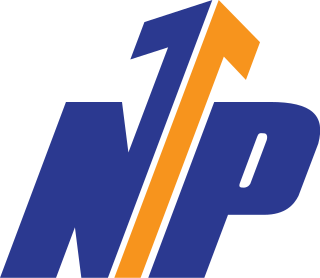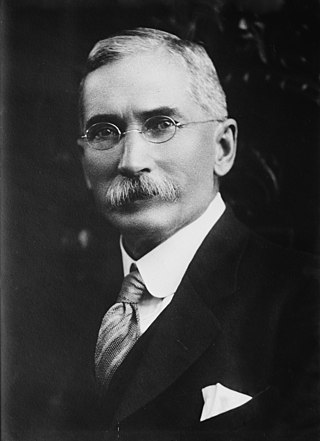
The National Party, also known as the Nationalist Party, was a political party in South Africa from 1914 to 1997, which was responsible for the implementation of apartheid rule. The party was an Afrikaner ethnic nationalist party, which initially promoted the interests of Afrikaners but later became a stalwart promoter and enactor of white supremacy, for which it is best known. It first became the governing party of the country in 1924. It merged with its rival, the SAP, during the Great Depression, and a splinter faction became the official opposition during World War II and returned to power. With the National Party governing South Africa from 4 June 1948 until 9 May 1994, the country for the bulk of this time was only a de jure or partial democracy, as from 1958 onwards non-white people were barred from voting. In 1990, it began to style itself as simply a South African civic nationalist party, and after the fall of apartheid in 1994, attempted to become a moderate conservative one. The party's reputation was damaged irreparably by perpetrating apartheid, and it rebranded itself as the New National Party in 1997 before eventually dissolving in 2005.

The United Party was a political party in South Africa. It was the country's ruling political party between 1934 and 1948.

General James Barry Munnik Hertzog, better known as Barry Hertzog or J. B. M. Hertzog, was a South African politician and soldier. He was a Boer general during the Second Boer War who served as the third prime minister of the Union of South Africa from 1924 to 1939. Hertzog advocated for the development of Afrikaner culture and was determined to prevent Afrikaners from being excessively influenced by British culture.

The 1929 United Kingdom general election was held on Thursday, 30 May 1929, and resulted in a hung parliament. Ramsay MacDonald's Labour Party won the most seats in the House of Commons for the first time despite receiving fewer votes than the Conservative Party, led by Prime Minister Stanley Baldwin. The Liberal Party, led again by former Prime Minister David Lloyd George, regained some of the ground lost in the 1924 general election and held the balance of power. Parliament was dissolved on 10 May.

The 1924 United Kingdom general election was held on Wednesday 29 October 1924, as a result of the defeat of the Labour minority government, led by Prime Minister Ramsay MacDonald, in the House of Commons on a motion of no confidence. It was the third general election to be held in less than two years. Parliament was dissolved on 9 October.

The Afrikaner Broederbond (AB) or simply the Broederbond was an exclusively Afrikaner Calvinist and male secret society in South Africa dedicated to the advancement of the Afrikaner people. It was founded by H. J. Klopper, H. W. van der Merwe, D. H. C. du Plessis and the Rev. Jozua Naudé in 1918 as Jong Zuid Afrika until 1920, when it was renamed the Broederbond. Its influence within South African political and social life came to a climax with the 1948-1994 rule of the white supremacist National Party and its policy of apartheid, which was largely developed and implemented by Broederbond members. Between 1948 and 1994, many prominent figures of Afrikaner political, cultural, and religious life, including every leader of the South African government, were members of the Afrikaner Broederbond.
The Cabinet of South Africa is the most senior level of the executive branch of the Government of South Africa. It is made up of the president, the deputy president, and the ministers.
The Senate was the upper house of the Parliament of South Africa between 1910 and its abolition from 1 January 1981, and between 1994 and 1997.
The South African Party was a political party that existed in the Union of South Africa from 1911 to 1934.

General elections were held in South Africa on 17 June 1924, electing 135 members of the House of Assembly. Considered a realigning election, rising discontent with the government of Jan Smuts led to the defeat of his government by a coalition of the pro-Afrikaner National Party and the South African Labour Party, a socialist party representing the interests of the white proletariat.

Colonel Frederic Hugh Page Creswell DSO was a Labour Party politician in South Africa. He was Minister of Defence from 30 June 1924 to 29 March 1933.
Jan Christiaan Smuts, OM served as Prime Minister of the Union of South Africa from 1919 to 1924 and from 1939 to 1948. He played a leading part in the post war settlements at the end of both world wars, making significant contributions towards the creation of both the League of Nations and the United Nations.

General elections were held in South Africa on 12 June 1929. The National Party under J. B. M. Hertzog won an outright majority in the House of Assembly. Hertzog had the opportunity to form a government without the aid of the Labour Party. In fact the Pact government continued, with two ministers from the Creswell Labour faction remaining in office. The National Party remained the dominant party, for its second consecutive term.

General elections were held in South Africa on 18 May 1938 to elect the 150 members of the House of Assembly. The United Party won an absolute majority.

General elections were held in South Africa on 7 July 1943 to elect the 150 members of the House of Assembly. The United Party of Jan Smuts won an absolute majority.

The South African Labour Party, was a South African political party formed in March 1910 in the newly created Union of South Africa following discussions between trade unions, the Transvaal Independent Labour Party, and the Natal Labour Party. It was a professedly democratic socialist party representing the interests of the white working class.

Nicolaas Christiaan Havenga better known as Klasie Havenga, was a South African politician who served as Finance Minister in the governments of J. B. M. Hertzog and D. F. Malan.

The Volksparty (VP) was a short-lived South African political party from 1939 to 1941.
Jan Smuts became South African Prime Minister for the second time in 1939, following a split in the United Party. He appointed members of the United Party, Dominion Party and Labour Party to positions in his Cabinet.

Walter Bayley Madeley was a leader of the South African Labour Party and a cabinet minister.













